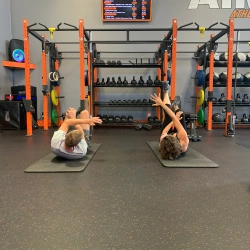

Hypermobility is one of those things that often goes unnoticed in a gym setting. Some people might say they’re double jointed or naturally flexible, but for many, it’s more than just a party trick. Hypermobility means your joints move beyond what’s considered a normal range of motion. In some cases, it’s simply a structural trait, but in others it’s connected to conditions like hypermobile Ehlers-Danlos Syndrome or Hypermobility Spectrum Disorder. These are connective tissue disorders that affect how the body holds itself together and they can have a big impact on how someone moves, trains, and recovers.
A common screening tool used to assess hypermobility is called the Beighton Score. It’s a nine point test that you can even try at home. You get one point for each side if you can bend your pinky finger back past 90 degrees, touch your thumb to your forearm, hyperextend your elbows past straight, or do the same with your knees. The final point is for placing your palms flat on the floor with straight legs. A score of five or more may suggest general joint hypermobility. That being said, this test has a major flaw. It mostly assesses the hands and knees and doesn’t account for other commonly affected joints like the hips, shoulders, or spine. At AIM Athletic, we see these kinds of issues show up all the time across our personal training, small group training, and active rehab sessions.
If someone is hypermobile, they tend to have a few recognizable traits. They often have narrow body types, walk with a soft, almost floating quality, and don’t love explosive movements like jumps, sprints, or anything that feels jarring. Their joints don’t absorb force as well and they often feel unstable or sore after high impact training. These people are frequently drawn to yoga or stretching routines, but those approaches can actually add to the problem. When your joints already move too much, putting them into extreme positions without the strength to support them can lead to more pain and even injury.
This is why strength training is one of the most effective ways to manage hypermobility. At AIM Athletic, we help our members build strength in a way that prioritizes control, tension, and awareness. That often means using partial range of motion, avoiding full lockout, and slowing down the pace of each rep. This gives the body time to build stability and allows muscles to take on the work that loose joints can't handle on their own. Whether someone is part of our hockey training program or rebuilding movement through active rehab, this kind of training builds a stronger, more resilient foundation.
Hypermobility doesn’t need to hold you back. With the right training approach and a program tailored to your body, you can improve stability, reduce pain, and feel more confident in every movement.
You've got the info, now it's time to take AIM!